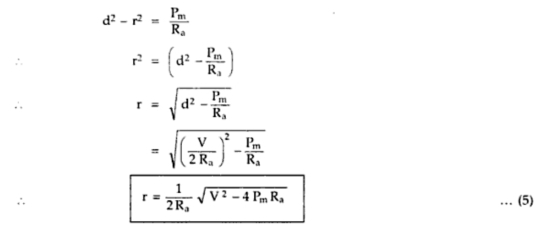The Blondel diagram of a synchronous motor is an extension of a simple phasor diagram of a synchronous motor.
For a synchronous motor, the power input to the motor per phase is given by,
Pin = Vph Iph cosΦ ............ per phase
The gross mechanical power developed per phase will be equal to the difference between Pin per phase and the per phase copper losses of the winding.
Copper loss per phase = (Iaph)2 Ra
... Pm = Vph Iph cosΦ - (Iaph)2 Ra .......... per phase
For mathematical convenience let Vph = V and Iaph = I,
... Pm = VI cos - I2 Ra
... I2 Ra - VI cos + Pm = 0
Now consider the phasor diagram as shown in the Fig. 1.
 |
| Fig. 1 |
The equation (1) represents polar equation to a circle. To obtain this circle in a phasor diagram, draw a line OY at an angle θ with respect to OA.
 |
| Fig. 2 Blondel diagram |
The circle represented by equation (1) has a centre at some point O' on the line OY. The circle drawn with centre as O' and radius as O'B represents circle of constant power. This is called Blondel diagram, shown in the Fig. 2.
Thus if excitation is varied while the power is kept constant, then working point B while move along the circle of constant power.
Let O'B = Radius of circle = r
OO' = Distant d
Applying cosine rule to triangle OBO',
Now OB represents resultant ER which is Ia Zs. Thus OB is proportional to current and when referred to OY represents the current in both magnitude and phase.
OB = Ia = I say
Substituting various values in equation (2) we get,
r2 = I2 + d2 - 2dI cosΦ
Comparing equations (1) and (3) we get,
Thus the point O' is independent of power Pm and is a constant for a give motor operating at a fixed applied voltage V.
Comparing last term of equations (1) and (3),
The equation shows that as power Pm must be real, then 4Pm Ra ≥ V2 . The maximum possible power per phase is,
And the radius of the circle for maximum power is zero. Thus at the time of maximum power, the circles becomes a point O'.
While when the power Pm = O, then
r = V/2Ra = OO'
This shows that the circle of zero power passes through the points O and A.
The radius for any power Pm is given by,
This is generalised expression for the radius for any power.







No comments:
Post a Comment